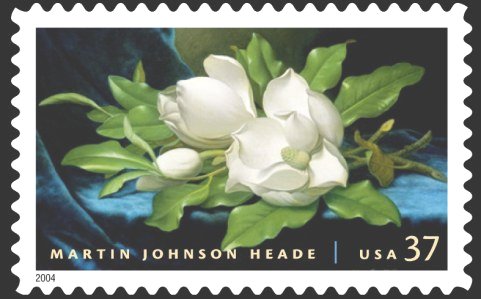 |
Stamp News Release Number: 04-050
ART OF MARTIN JOHNSON
HEADE IS FIRST-CLASS CHOICE FOR USPS POSTAGE STAMP
WASHINGTON – A circa 1890
oil-on-canvas painting by Martin Johnson Heade, “Giant Magnolias on a Blue Velvet
Cloth,” will be the subject of the newest commemorative postage stamp in the U.S.
Postal Service’s American Treasures series. Heade is considered one of the finest
19th-century painters of landscapes and still lifes. The painting is in the collection of
the National Gallery of Art in Washington, D.C.
The first-day-of-issue dedication ceremony is scheduled for noon, PT, August 12, at the
Sacramento Convention Center, 1400 J St., Rooms 306-308, Sacramento, CA. The ceremony is
free and open to the public, and will take place during the first day of the American
Philatelic Society’s (APS) StampShow 2004.
“The Martin Johnson Heade stamp demonstrates the beauty and craftsmanship that is
America,” said Robert Rider, presidentially appointed member, U.S. Postal Service
Board of Governors, who will dedicate the stamp. “What better way for us to celebrate
our culture … our heritage … and our history … than through the diversity
of designs in the American Treasures series that have captured the spirit and creativity
of this nation.”
In addition to Rider, others scheduled to participate in the ceremony are Janet Klug,
president, American Philatelic Society; Elizabeth C. Pope, president, American Stamp
Dealers Association; and John M. Hotchner, member, Citizens’ Stamp Advisory
Committee, U.S. Postal Service.
Inaugurated in 2001 with the Amish Quilts stamp pane, the American Treasures series
showcases beautiful works of American fine art and crafts. The 2002 and 2003 issuances
featured artwork by John James Audubon and Mary Cassatt respectively.
Born August 11, 1819, in rural Lumberville, PA, Martin Johnson Heade started painting in
his late teens. He initially received instruction from the folk artist Edward Hicks and
then traveled in the United States and Europe, copying works by the masters and painting
portraits and genre scenes. In the late 1850s, influenced by Hudson River School artists
such as Frederic Edwin Church, he began painting landscapes and still lifes.
From the early 1860s—when he began to develop his own very individual style—to
the early 1880s, Heade painted coastal and inland views, floral still lifes and tropical
landscapes with hummingbirds and flowers. He continued to travel, making three trips to
South and Central America: Brazil in 1863-64; Nicaragua in 1866; and Colombia, Panama and
Jamaica in 1870.
In 1883, Heade married and settled in St. Augustine, FL, continuing to paint in the
realist style, which was then becoming out of date. He made numerous views of
Florida’s rivers and marshes, but his primary subject became the state’s native
flowers, especially the Cherokee rose and the giant magnolia.
Heade—who continued working until shortly before he died on September 4,
1904—had the longest career and was perhaps the most versatile of the 19th-century
American painters. A prolific artist who exhibited widely, he was only moderately
successful during his lifetime and was forgotten for decades after his death. Rediscovered
in the 1940s, Heade is now respected and admired as a remarkably talented and innovative
painter.
“Giant Magnolias on a Blue Velvet Cloth” was included in the mid-1980s
exhibition “A New World: Masterpieces of American Painting, 1760-1910.” Two
major retrospective exhibitions of Heade’s work were mounted in 1969 and 1999.